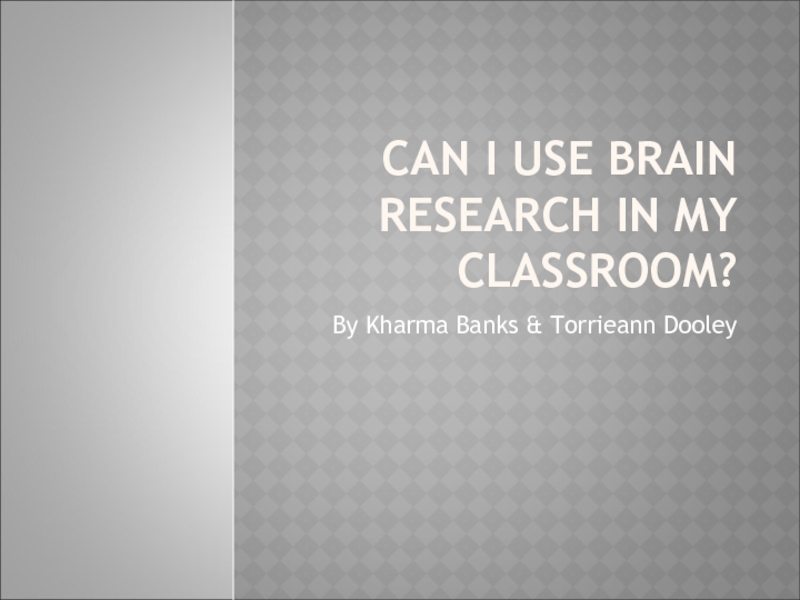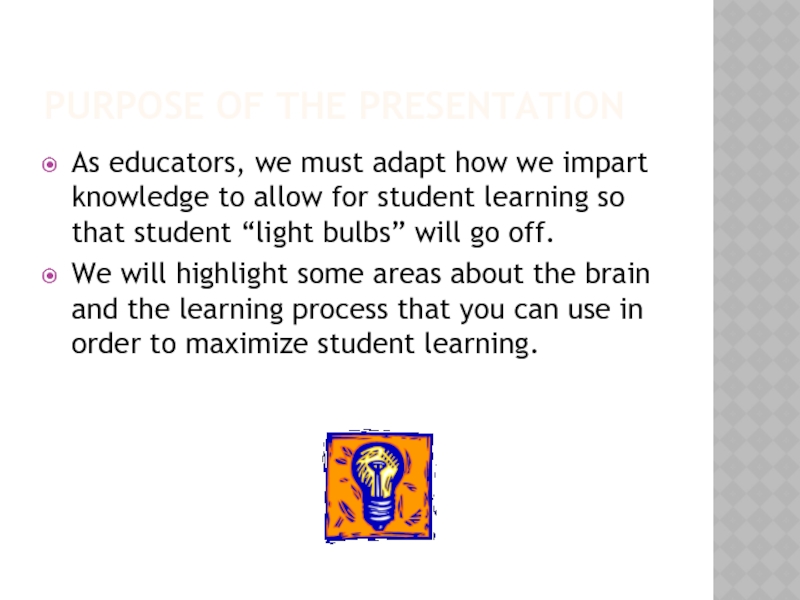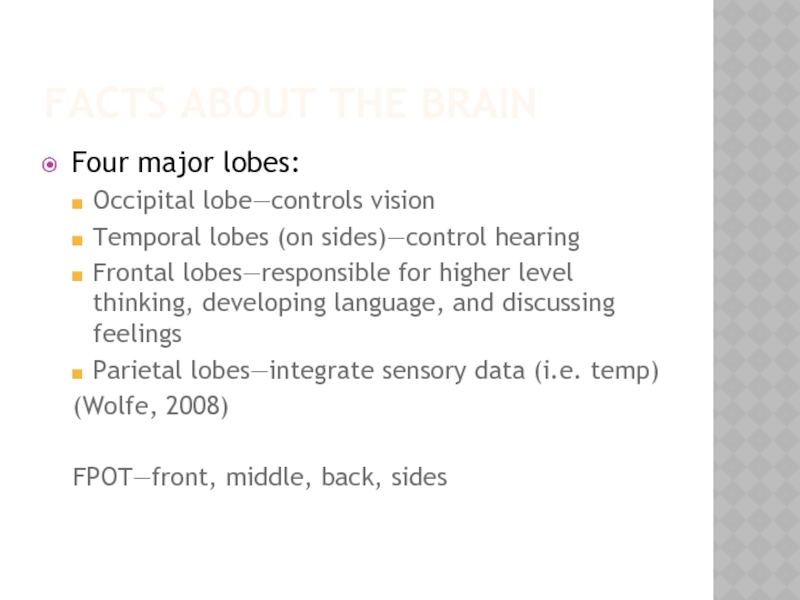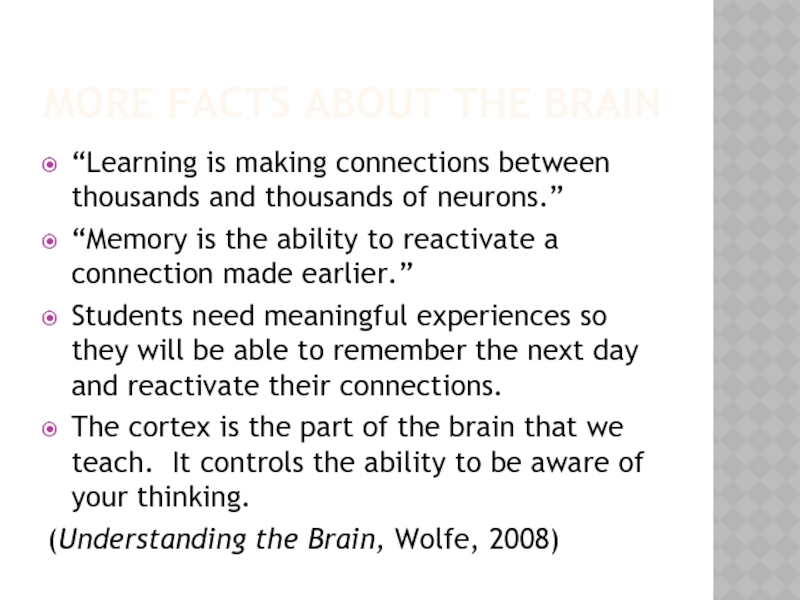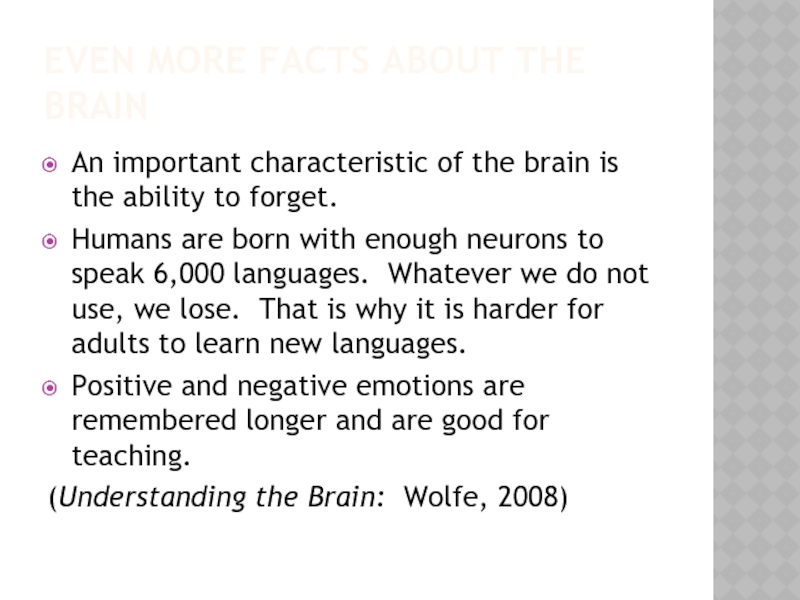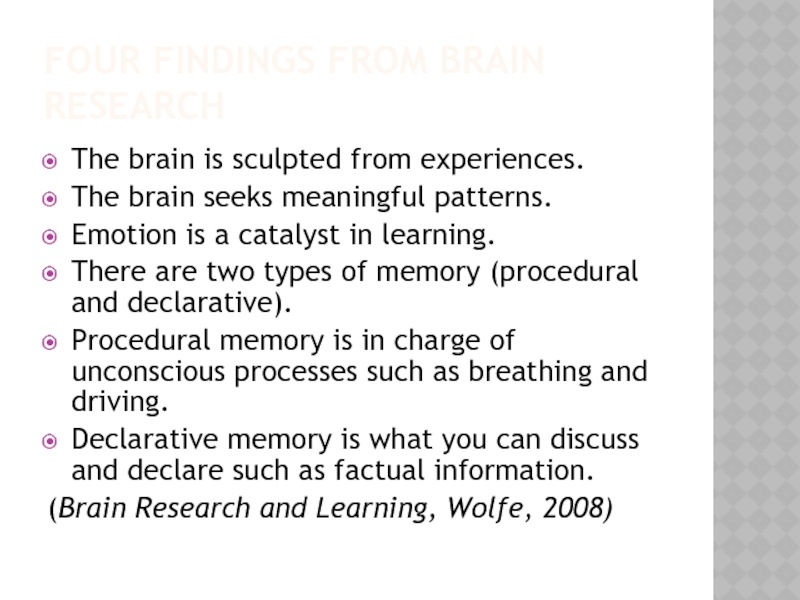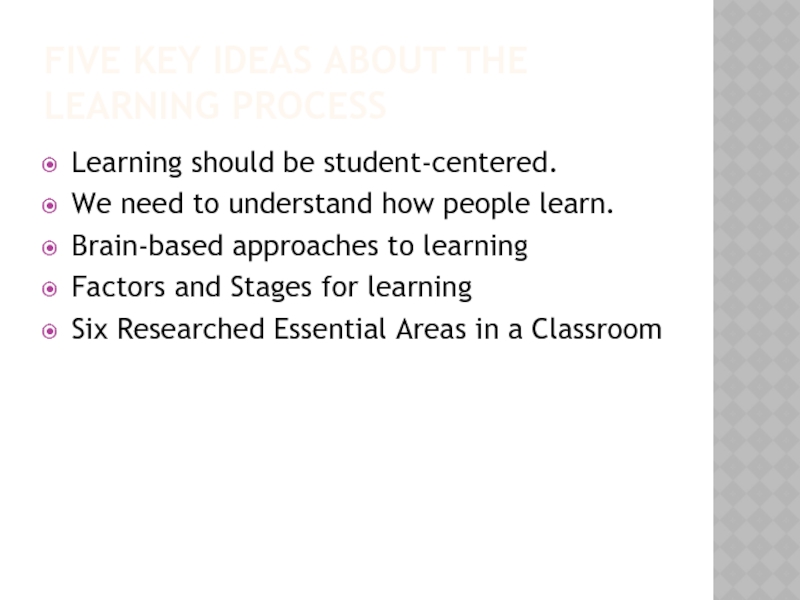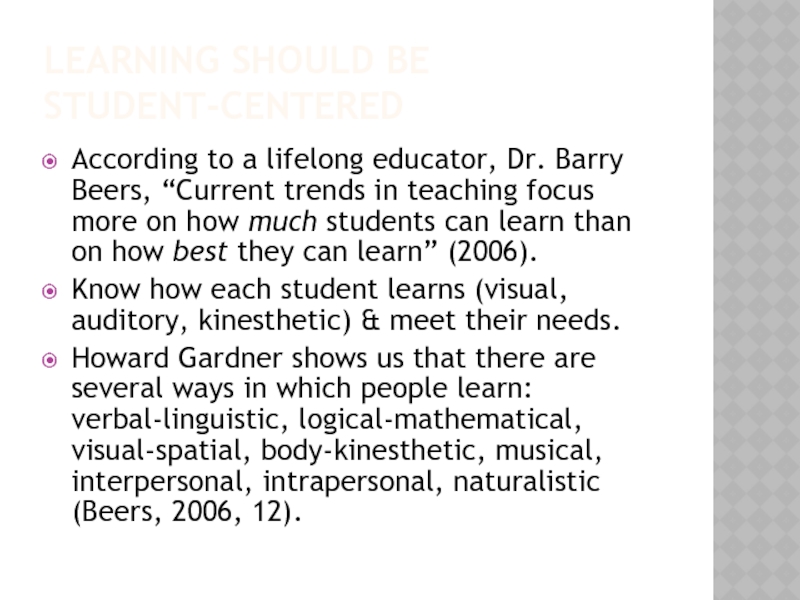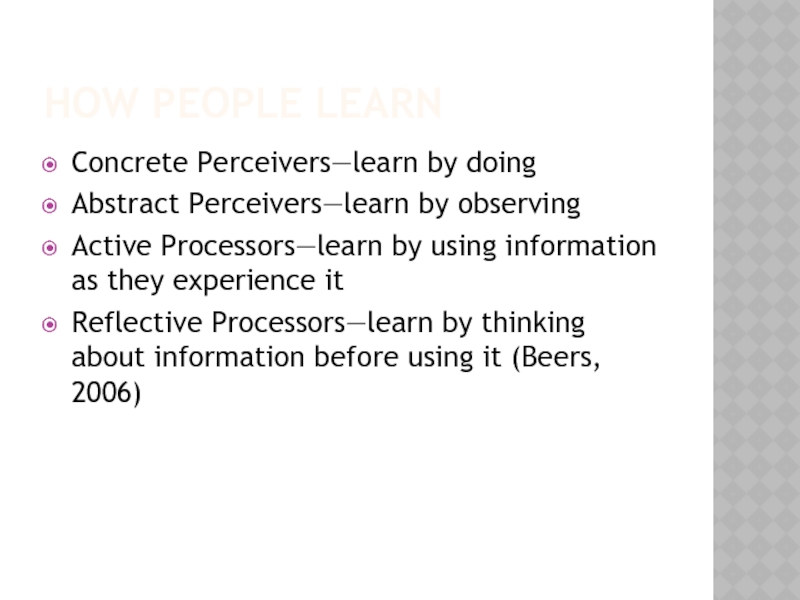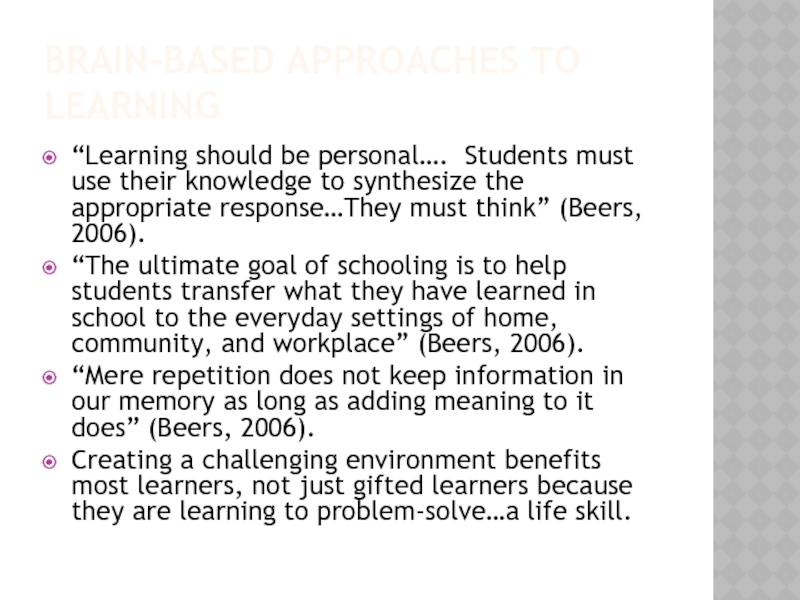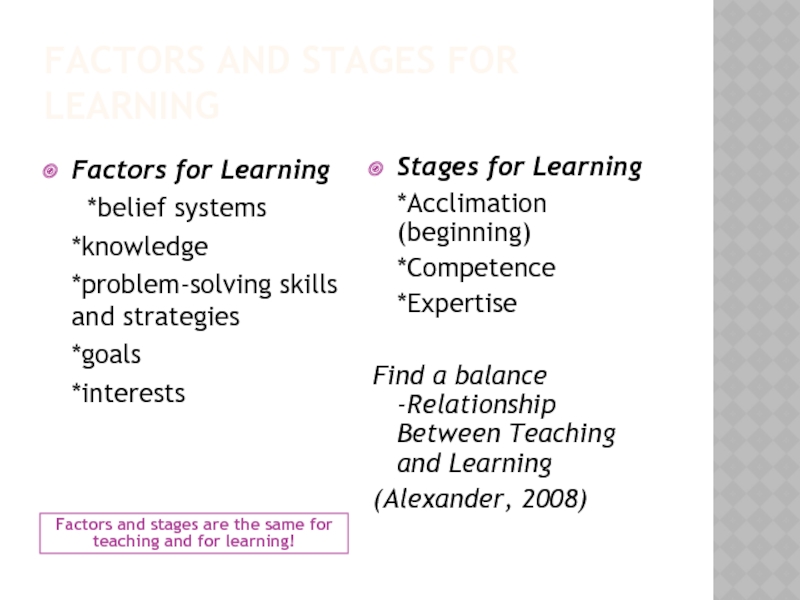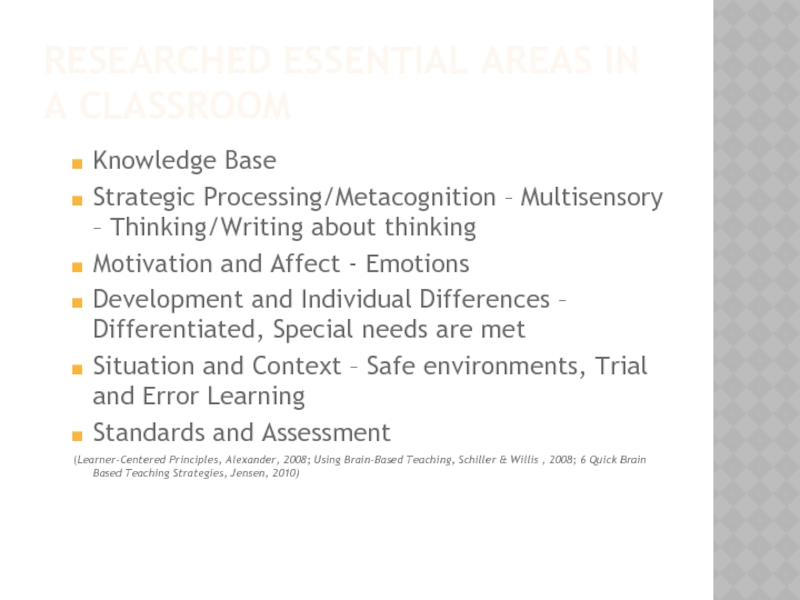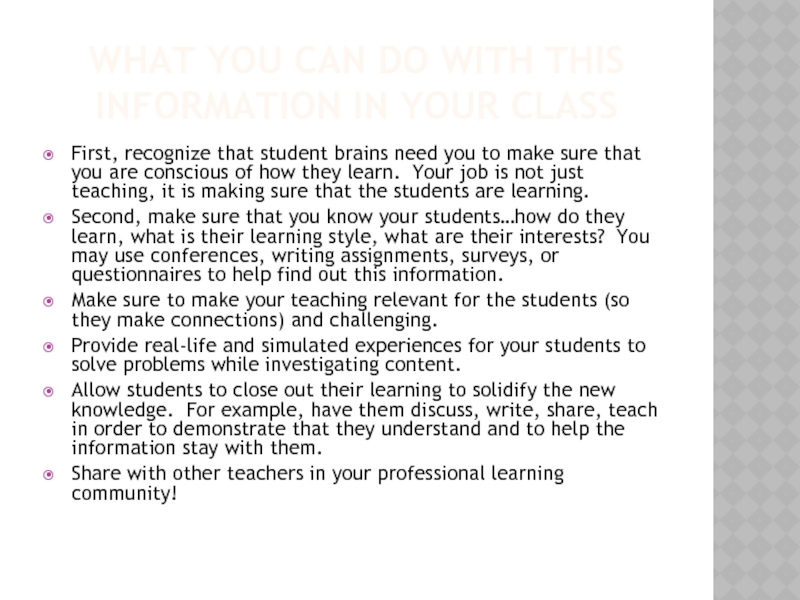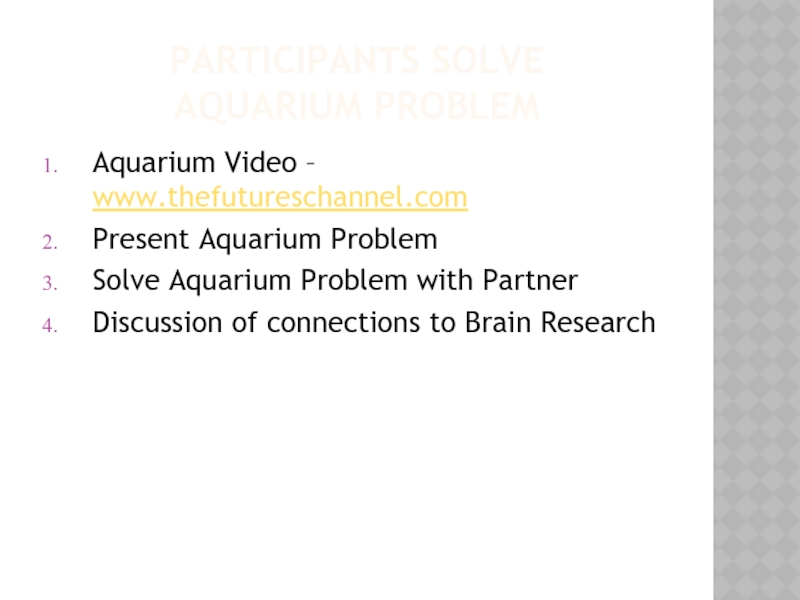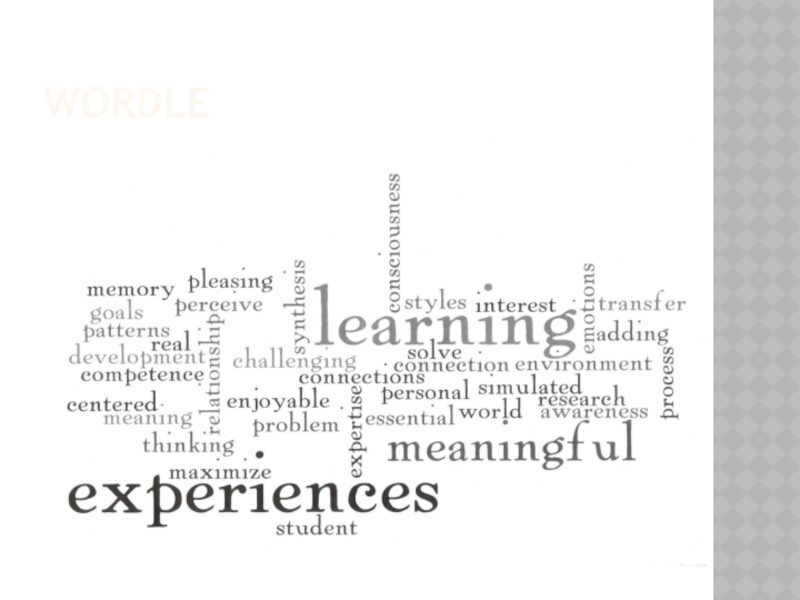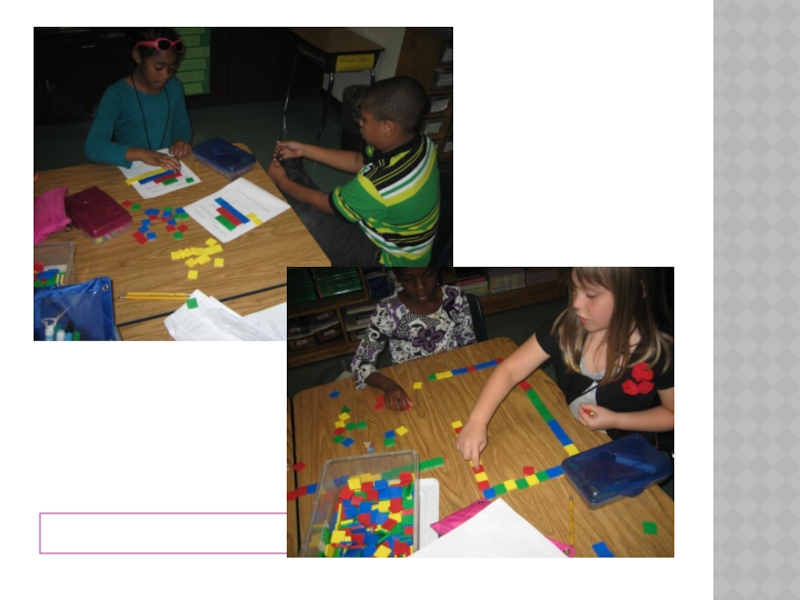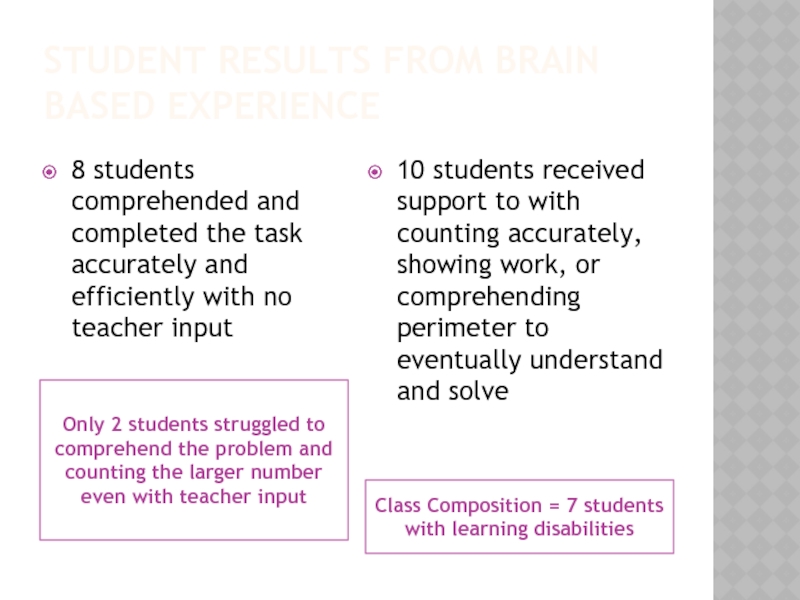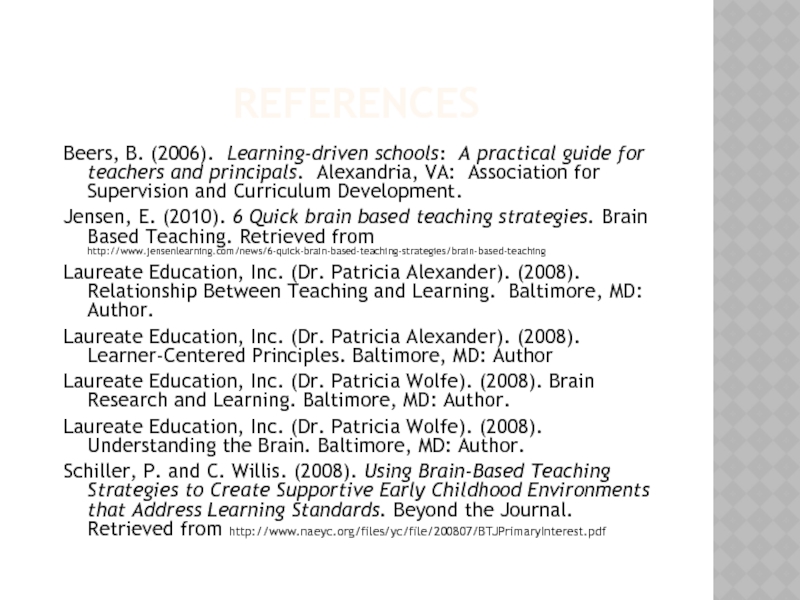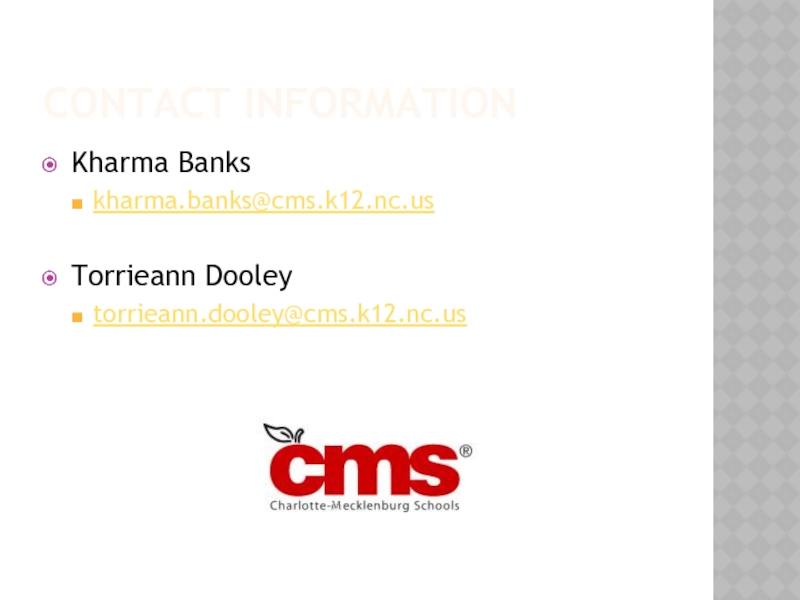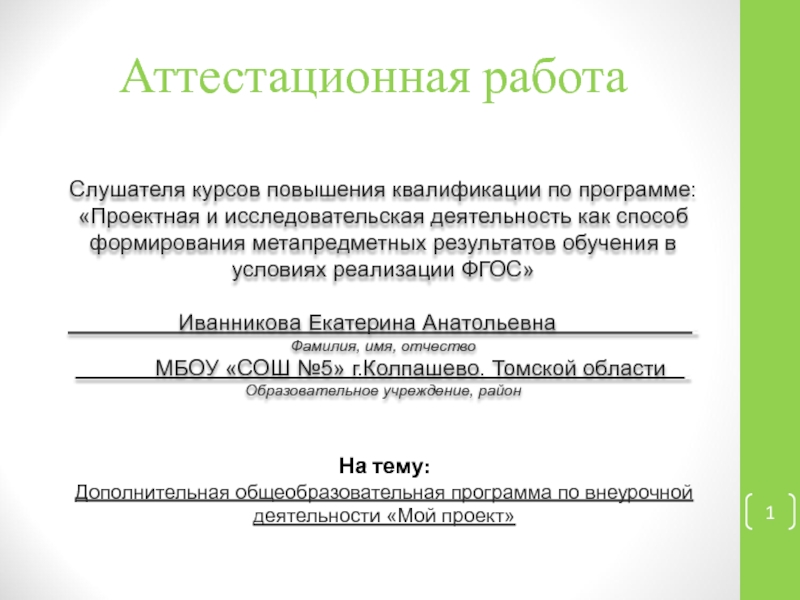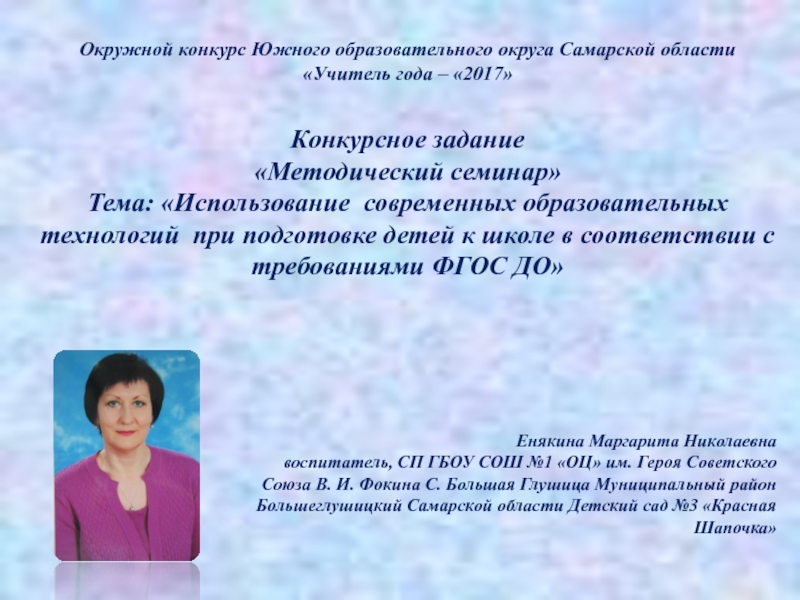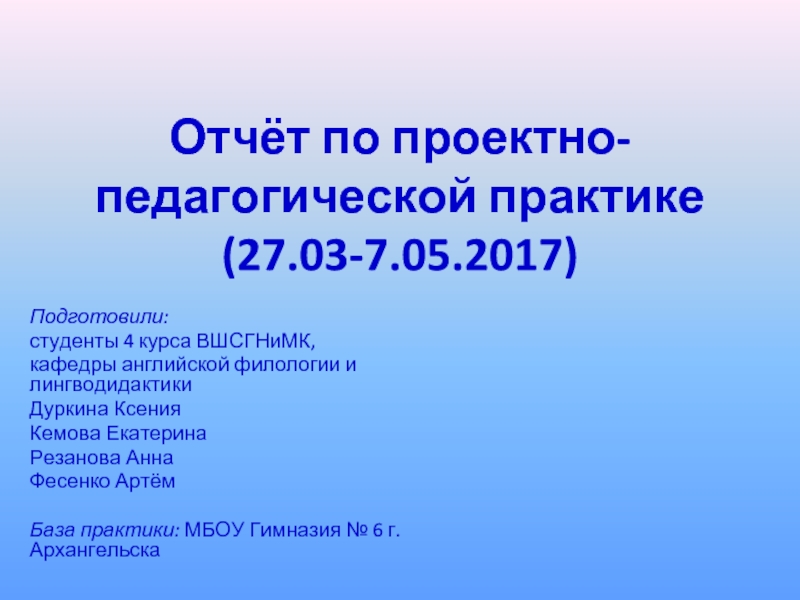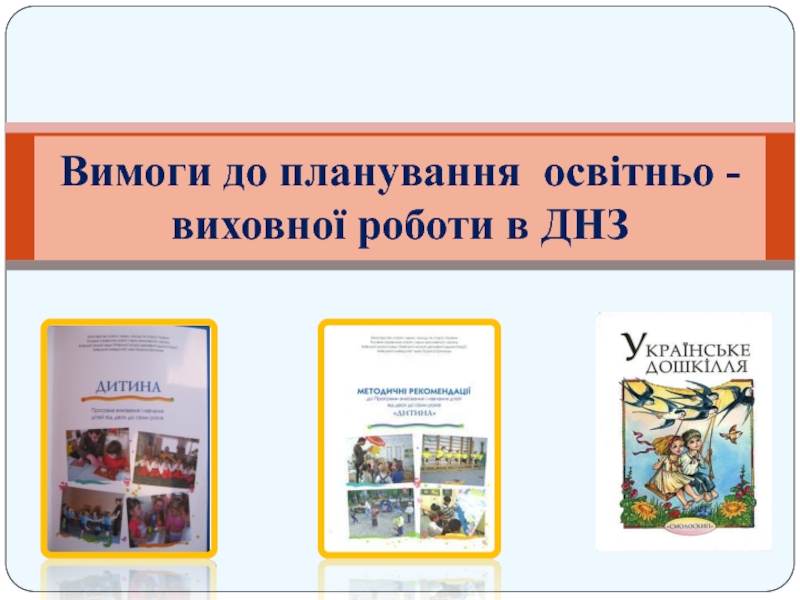- Главная
- Разное
- Дизайн
- Бизнес и предпринимательство
- Аналитика
- Образование
- Развлечения
- Красота и здоровье
- Финансы
- Государство
- Путешествия
- Спорт
- Недвижимость
- Армия
- Графика
- Культурология
- Еда и кулинария
- Лингвистика
- Английский язык
- Астрономия
- Алгебра
- Биология
- География
- Детские презентации
- Информатика
- История
- Литература
- Маркетинг
- Математика
- Медицина
- Менеджмент
- Музыка
- МХК
- Немецкий язык
- ОБЖ
- Обществознание
- Окружающий мир
- Педагогика
- Русский язык
- Технология
- Физика
- Философия
- Химия
- Шаблоны, картинки для презентаций
- Экология
- Экономика
- Юриспруденция
Can i use brain research in my classroom презентация
Содержание
- 1. Can i use brain research in my classroom
- 2. PURPOSE OF THE PRESENTATION As educators, we
- 3. FACTS ABOUT THE BRAIN Four major lobes:
- 4. MORE FACTS ABOUT THE BRAIN “Learning is
- 5. EVEN MORE FACTS ABOUT THE BRAIN An
- 6. FOUR FINDINGS FROM BRAIN RESEARCH The brain
- 7. FIVE KEY IDEAS ABOUT THE LEARNING PROCESS
- 8. LEARNING SHOULD BE STUDENT-CENTERED According to a
- 9. HOW PEOPLE LEARN Concrete Perceivers—learn by
- 10. BRAIN-BASED APPROACHES TO LEARNING “Learning should be
- 11. FACTORS AND STAGES FOR LEARNING Factors and
- 12. RESEARCHED ESSENTIAL AREAS IN A CLASSROOM Knowledge
- 13. WHAT YOU CAN DO WITH THIS INFORMATION
- 14. PARTICIPANTS SOLVE AQUARIUM PROBLEM Aquarium Video
- 15. WORDLE
- 17. STUDENT RESULTS FROM BRAIN BASED EXPERIENCE Only
- 18. REFERENCES Beers, B. (2006). Learning-driven schools: A
- 19. CONTACT INFORMATION Kharma Banks kharma.banks@cms.k12.nc.us Torrieann Dooley torrieann.dooley@cms.k12.nc.us
Слайд 2PURPOSE OF THE PRESENTATION
As educators, we must adapt how we impart
We will highlight some areas about the brain and the learning process that you can use in order to maximize student learning.
Слайд 3FACTS ABOUT THE BRAIN
Four major lobes:
Occipital lobe—controls vision
Temporal lobes (on sides)—control
Frontal lobes—responsible for higher level thinking, developing language, and discussing feelings
Parietal lobes—integrate sensory data (i.e. temp)
(Wolfe, 2008)
FPOT—front, middle, back, sides
Слайд 4MORE FACTS ABOUT THE BRAIN
“Learning is making connections between thousands and
“Memory is the ability to reactivate a connection made earlier.”
Students need meaningful experiences so they will be able to remember the next day and reactivate their connections.
The cortex is the part of the brain that we teach. It controls the ability to be aware of your thinking.
(Understanding the Brain, Wolfe, 2008)
Слайд 5EVEN MORE FACTS ABOUT THE BRAIN
An important characteristic of the brain
Humans are born with enough neurons to speak 6,000 languages. Whatever we do not use, we lose. That is why it is harder for adults to learn new languages.
Positive and negative emotions are remembered longer and are good for teaching.
(Understanding the Brain: Wolfe, 2008)
Слайд 6FOUR FINDINGS FROM BRAIN RESEARCH
The brain is sculpted from experiences.
The brain
Emotion is a catalyst in learning.
There are two types of memory (procedural and declarative).
Procedural memory is in charge of unconscious processes such as breathing and driving.
Declarative memory is what you can discuss and declare such as factual information.
(Brain Research and Learning, Wolfe, 2008)
Слайд 7FIVE KEY IDEAS ABOUT THE LEARNING PROCESS
Learning should be student-centered.
We need
Brain-based approaches to learning
Factors and Stages for learning
Six Researched Essential Areas in a Classroom
Слайд 8LEARNING SHOULD BE STUDENT-CENTERED
According to a lifelong educator, Dr. Barry Beers,
Know how each student learns (visual, auditory, kinesthetic) & meet their needs.
Howard Gardner shows us that there are several ways in which people learn: verbal-linguistic, logical-mathematical, visual-spatial, body-kinesthetic, musical, interpersonal, intrapersonal, naturalistic (Beers, 2006, 12).
Слайд 9HOW PEOPLE LEARN
Concrete Perceivers—learn by doing
Abstract Perceivers—learn by observing
Active Processors—learn
Reflective Processors—learn by thinking about information before using it (Beers, 2006)
Слайд 10BRAIN-BASED APPROACHES TO LEARNING
“Learning should be personal…. Students must use their
“The ultimate goal of schooling is to help students transfer what they have learned in school to the everyday settings of home, community, and workplace” (Beers, 2006).
“Mere repetition does not keep information in our memory as long as adding meaning to it does” (Beers, 2006).
Creating a challenging environment benefits most learners, not just gifted learners because they are learning to problem-solve…a life skill.
Слайд 11FACTORS AND STAGES FOR LEARNING
Factors and stages are the same for
Factors for Learning
*belief systems
*knowledge
*problem-solving skills and strategies
*goals
*interests
Stages for Learning
*Acclimation (beginning)
*Competence
*Expertise
Find a balance -Relationship Between Teaching and Learning
(Alexander, 2008)
Слайд 12RESEARCHED ESSENTIAL AREAS IN A CLASSROOM
Knowledge Base
Strategic Processing/Metacognition – Multisensory
Motivation and Affect - Emotions
Development and Individual Differences – Differentiated, Special needs are met
Situation and Context – Safe environments, Trial and Error Learning
Standards and Assessment
(Learner-Centered Principles, Alexander, 2008; Using Brain-Based Teaching, Schiller & Willis , 2008; 6 Quick Brain Based Teaching Strategies, Jensen, 2010)
Слайд 13WHAT YOU CAN DO WITH THIS INFORMATION IN YOUR CLASS
First, recognize
Second, make sure that you know your students…how do they learn, what is their learning style, what are their interests? You may use conferences, writing assignments, surveys, or questionnaires to help find out this information.
Make sure to make your teaching relevant for the students (so they make connections) and challenging.
Provide real-life and simulated experiences for your students to solve problems while investigating content.
Allow students to close out their learning to solidify the new knowledge. For example, have them discuss, write, share, teach in order to demonstrate that they understand and to help the information stay with them.
Share with other teachers in your professional learning community!
Слайд 14PARTICIPANTS SOLVE
AQUARIUM PROBLEM
Aquarium Video – www.thefutureschannel.com
Present Aquarium Problem
Solve Aquarium Problem
Discussion of connections to Brain Research
Слайд 17STUDENT RESULTS FROM BRAIN BASED EXPERIENCE
Only 2 students struggled to comprehend
Class Composition = 7 students with learning disabilities
8 students comprehended and completed the task accurately and efficiently with no teacher input
10 students received support to with counting accurately, showing work, or comprehending perimeter to eventually understand and solve
Слайд 18REFERENCES
Beers, B. (2006). Learning-driven schools: A practical guide for teachers and
Jensen, E. (2010). 6 Quick brain based teaching strategies. Brain Based Teaching. Retrieved from http://www.jensenlearning.com/news/6-quick-brain-based-teaching-strategies/brain-based-teaching
Laureate Education, Inc. (Dr. Patricia Alexander). (2008). Relationship Between Teaching and Learning. Baltimore, MD: Author.
Laureate Education, Inc. (Dr. Patricia Alexander). (2008). Learner-Centered Principles. Baltimore, MD: Author
Laureate Education, Inc. (Dr. Patricia Wolfe). (2008). Brain Research and Learning. Baltimore, MD: Author.
Laureate Education, Inc. (Dr. Patricia Wolfe). (2008). Understanding the Brain. Baltimore, MD: Author.
Schiller, P. and C. Willis. (2008). Using Brain-Based Teaching Strategies to Create Supportive Early Childhood Environments that Address Learning Standards. Beyond the Journal. Retrieved from http://www.naeyc.org/files/yc/file/200807/BTJPrimaryInterest.pdf
